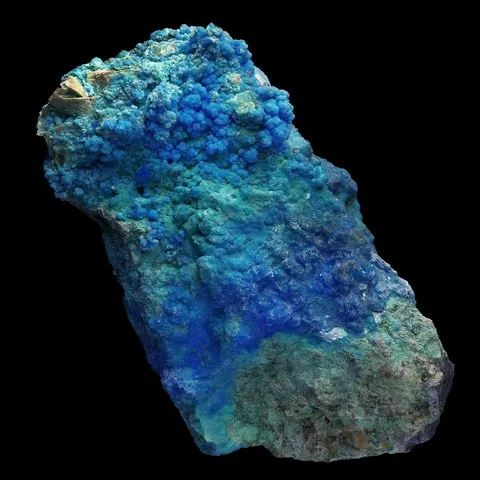CHALCANTHITE
Class : Sulfates, chromates, molybdates
Subclass : Hydrated sulfates
Crystal System : Triclinic
Chemistry : CuSO4 5H2O
Rarity : Common
Chalcanthite is a frequent secondary mineral in the oxidation zone of copper deposits, especially in arid zones because it is very soluble. It is associated with other sulphates and secondary copper minerals. It is frequently a mineral of current formation (neoformed), arising in mine galleries from acidic waters which carry copper in solution. Its name comes from the Latin chalcanthum (copper flower), it has been known since Antiquity. Its crystals are rare, generally short prismatic, less commonly tabular ; artificial crystals, very easy to obtain, are often more aesthetic than natural ones. Chalcanthite is much more often massive, concreted or stalactitic, with a fibrous structure. It is characterized by its sky blue to Prussian blue color, a high translucency and, for amateurs because toxic, by a sweetish metallic taste. Some industrial copper recovery processes by dissolution (leaching) artificially form chalcanthite, the copper then being recovered by precipitation on iron. It is a mineral which bleaches by dehydration. Locally, chalcanthite is a significant copper ore.
Main photo : Fibrous chalcanthite from Helvetia Mine, Arizona, USA
Chalcanthite in the World
Chalcanthite in France
In France, we find chalcanthite in very aesthetic decimetric stalactites in the galleries of the old mine of Chessy (Rhône). It is also reported in small blooms in Barlet and Marsanges (Haute-Loire), Salsigne (Aude), Montroc (Tarn), Cap Garonne (Var) and Canaveille (Pyrénées-Orientales).
Twinning
Chalcanthite rarely forms cruciform twins.
Fakes and treatments
Chalcanthite has long been synthesized to produce spectacular sets of intense blue crystals. If these samples have almost completely deserted the mineral shows for many years, we find on the web very beautiful crystals of chalcantite for sale. The crystals measure up to 10 cm and are on matrix of natural rocks or on other natural mineral species such as quartz. Chalcantite is a hydrated copper sulphate that can be easily purchased in powder form, it is used in agriculture as a fungicide. By saturating a solution of heated distilled water with this copper sulfate, then allowing the solution to cool and evaporate, it is possible to grow such crystals very easily in either on just about anything. Be careful, however, these crystals are not stable, they are sensitive to water and dissolve easily. As with time and with dehydration, they turn white to become opaque and whitish. Copper sulphate is harmful if swallowed and irritating to the eyes and skin, so these samples should not be passed on to all hands.
Hardness : 2.5
Density : 2.29
Fracture : Conchoidal
Streak : White
TP : Translucent to transparent
RI : 1.514 to 1.543
Birefringence : 0.029
Optical character : Biaxial -
Pleochroism : Weak
Fluorescence : None
Solubility : Water
Magnetism : None
Radioactivity : None





